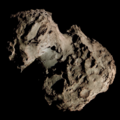C/1854 L1 (Klinkerfues)
| Discovery | |
|---|---|
| Discovered by | Wilhelm Klinkerfues |
| Discovery date | 6 June 1854 |
| Designations | |
| 1854 III[1] | |
| Orbital characteristics[2][3] | |
| Epoch | 22 May 1854 (JD 2398360.5) |
| Observation arc | 54 days |
| Number of observations | 262 |
| Perihelion | 0.648 AU |
| Semi-major axis | ~480 AU |
| Eccentricity | 0.99866 |
| Orbital period | ~10,600 years |
| Inclination | 131.69° |
| 346.88° | |
| Argument of periapsis | 344.95° |
| Mean anomaly | 359.20° |
| Last perihelion | 22 June 1854 |
| Physical characteristics[4][5] | |
Mean diameter | ~4.8 km (3.0 mi) |
| Comet total magnitude (M1) | 6.4 |
| 4.0 (1854 apparition) | |
C/1854 L1 (Klinkerfues) is a non-periodic comet that became barely visible to the naked eye between June and July 1854. It is the second of six comets discovered by the German astronomer, Wilhelm Klinkerfues.
Orbit
[edit]Initial orbital calculations by Friedrich Winnecke in 1855 resulted in a parabolic trajectory for the comet.[6] Several attempts to compute an elliptical orbit were conducted since then, including by Klinkerfues himself where he noted that the orbit of C/1854 L1 is similar to those of the comets that appeared in 961 (C/962 B2) and 1558 (C/1558 P1) respectively.[4] The possibility that C/1854 L1 is related to the comet of 961 AD was further explored in 1981, where it was tentatively assigned as the parent body of the ε-Eridanid meteor stream.[7] This resulted in a Halley-type orbital period of approximately 127 years,[5] however further calculations by Jeremie Vaubaillon and Peter Jenniskens ruled out a link between the two comets, as the simulated dust generated did not match those observed in the aforementioned 1981 meteor shower.[5]
A more definitive orbit was calculated by Richard L. Branham, Jr. in 2013, where he concluded that the comet has a highly-elliptical orbit that is completed once every 10,600 years and thus presents no immediate threat to Earth.[2]
References
[edit]- ^ "Comet Names and Designations". International Comet Quarterly. Retrieved 30 June 2025.
- ^ a b R. L. Branham Jr. (2013). "Orbit of Comet C/1854 L1 (Klinkerfues)" (PDF). Planetary & Space Science. 85: 289–292. Bibcode:2013P&SS...85..289B. doi:10.1016/j.pss.2013.06.023.
- ^ "C/1854 L1 (Klinkerfues) – JPL Small-Body Database Lookup". ssd.jpl.nasa.gov. Jet Propulsion Laboratory. Retrieved 30 June 2025.
- ^ a b G. W. Kronk (2003). Cometography: A Catalog of Comets. Vol. 2: 1800–1899. Cambridge University Press. pp. 234–236. ISBN 978-0-521-58505-7.
- ^ a b c J. Vaubaillon; P. Jenniskens (2007). "Dust trail evolution applied to long-period comet C/1854 L1 (Klinkerfues) and the ε-Eridanids". Advances in Space Research. 39 (4): 612–615. Bibcode:2007AdSpR..39..612V. doi:10.1016/j.asr.2005.11.001.
- ^ F. A. Winnecke; C. F. Pape (1855). "Bahnbestimmung des Cometen 1854 III". Astronomische Nachrichten (in German). 42 (8): 113. Bibcode:1855AN.....42..113W. doi:10.1002/asna.18550420801.
- ^ E. Lyytinen; P. Jenniskens (2003). "Meteor outbursts from long-period comet dust trails" (PDF). Icarus. 162 (2): 443–452. Bibcode:2003Icar..162..443L. doi:10.1016/S0019-1035(02)00071-4.
External links
[edit]- C/1854 L1 at the JPL Small-Body Database


